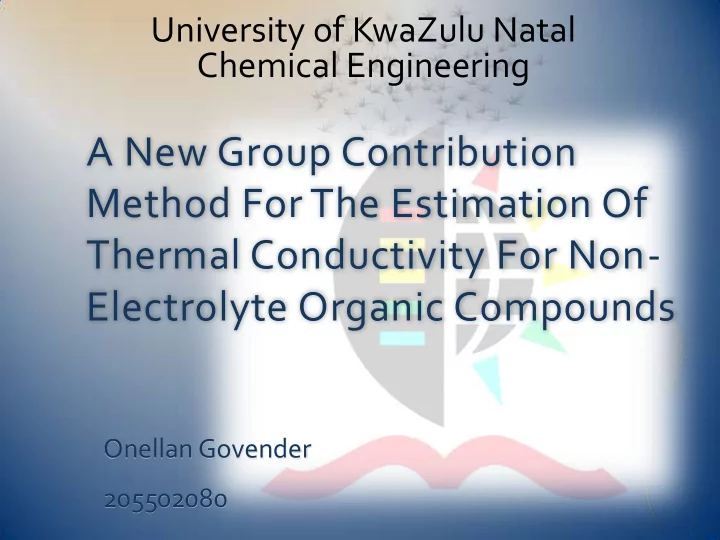

University of KwaZulu Natal Chemical Engineering A New Group Contribution Method For The Estimation Of Thermal Conductivity For Non- Electrolyte Organic Compounds Onellan Govender 205502080
Experimentation Verses Prediction 2
Thermal Conductivity Required for Equipment design Cost-effective and safe plant design Simulation packages Scale up Calculation of transfer coefficients and dimensionless numbers 3
4
Thermal Conductivity Required for Equipment design Cost-effective and safe plant design Simulation packages Scale up Calculation of transfer coefficients and dimensionless numbers 5
Previous Work Done Normal boiling point (Rarey and Cordes 2002 and Nannoolal et al. 2004) Critical property data (Nannoolal et al . 2007) Vapour pressures (Nannoolal et al . 2008 and Moller et al . 2008) Liquid viscosity (Nannoolal et al . 2009) 6
Current Work Bruce Moller – Gamma infinity in water, alkanes, alcohols Eugene Olivier – Surface Tension Onellan Govender – Thermal Conductivity 7
λ (W/m.K) Thermal Conductivity - λ J q Theoretical Contributions and Considerations Critical Enhancement ( , ) T ( ) T ( , ) T n o n ( , ) T c n 8
Thermal Conductivity of Propane as f(T,P) ( , ) ( ) ( , ) ( , ) T T T T n o n c n 9
Critical Enhancement Selected isotherms for CO 2 depicting the critical enhancement phenomenon (Mathias et al . 2002) Tc + 0.25K Tc + 0.33K Factor of 16 Tc + 0.74K Tc + 2.09K 10
Correlation and Prediction Experiments and Data Correlation Prediction Models Corresponding States General Correlations Family Methods Group Contribution Method 11
General Correlation Methods Sato and Reidel (1977) Lakshmi and Prasad (1992) Family Methods Latini et al . (1977) 12
General Correlation Methods Thermal Conductivity of Octane as f(T) at 1atm 0.16 Thermal Conductivity (W/(m.K)) 0.15 0.14 0.13 0.12 0.11 0.1 0.09 0.08 200 250 300 350 400 450 Temperature (K) Lakshmi & Prasad Sato & Riedel Experimental Data Linear (Experimental Data) 13
General Correlation Methods Thermal Conductivity of Methylcyclopentane as f(T) at 1atm 0.15 Thermal Conductivity (W/(m.K)) 0.14 0.13 0.12 0.11 0.1 250 260 270 280 290 300 310 320 Temperature (K) Lakshmi & Prasad Sato & Riedel Experimental Data Linear (Experimental Data) 14
Previous Group Contribution Methods Sakiadis and Coates (1955 , 1957) Robbins & Kingrea (1962) Nagvekar & Daubert (1987) Assael, Charitidou & Wakeham (1989) Sastri and Rao (1993) Rodenbush, Viswanath & Hsieh (1999) Sastri and Rao (1999) 15
Literature Review & Method Test Component Classes Oxygen Hydrocarbons Ethers Aldehydes Compounds Aromatic Carboxylic Nitrogen Esters Hydrocarbons Acids Compounds Halogen Alcohols Ketones Amines Compounds Sato & Nagvekar & Lakshmi & Sastri & Methods Riedel Daubert Prasad Rao (1997) (1987) (1992) (1993) RMD (%) 19.81 16.64 23.41 14.11 Number of Components 500 322 500 469 16
Data Filtration and Validation DDB – 100 515 data points for 876 components Figure : Data points for n-butane ( 1 atm isobar; 135.75 < T (K) < 272.65) 17
Data Filtration and Validation Figure : All experimental data points for n-butane (135.75 < T (K) < 423.61; 101.325 < P (kPa) < 70000) 18
Model Idea Separate group contributions for the 3 parts ( , ) T P ( T ) f T ( T ) g P ( 101.3 kPa ) Ref Ref Reference Value Temperature Dependence Pressure Dependence T T REF REF P T P 101.325 P T T P REF P T 19
Software Development The DDB (Artist) Microsoft Office SQL & ADO 20
Future Work Select a regression model and determine empirical parameters for all compounds Evaluation & definition of structural groups Regression for structural or bond contributions Testing using a test set of thermal conductivity data Optimisation of structural or bond contributions 21
Summary Importance of prediction methods Thermal Conductivity Review of available prediction methods Evaluation of methods Filtration and validation of data from DDB Software Work left to be done 22
Acknowledgements Prof. D. Ramjugernath from UKZN Prof. J. Rarey and Prof. J. Gmehling from Oldenburg University Bruce Moller and Eugene Olivier DDBST Software and Separation Technology South African NRF and German DLR (BMBF) 23
Recommend
More recommend